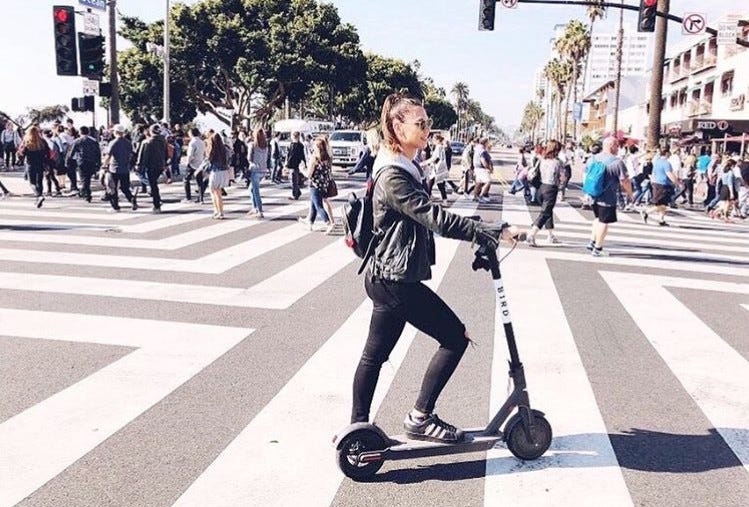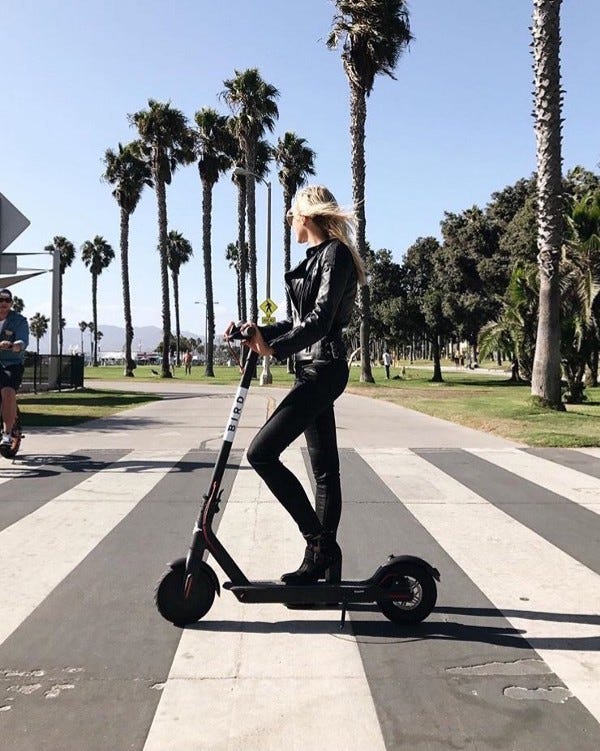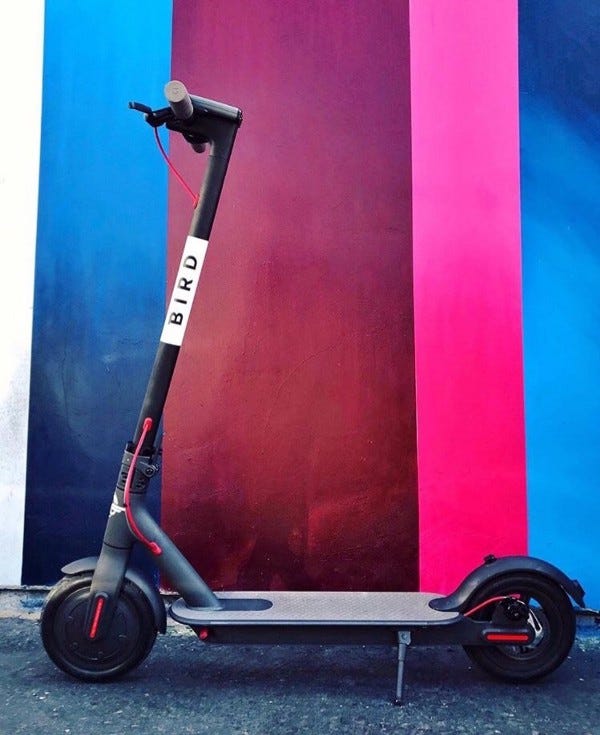Bird is the Word: E-Scooters Take Over LA
I noticed them right away when I moved to Santa Monica: sleek, black scooters lined up on the sidewalk. Sitting there idly. Practically…

I noticed them right away when I moved to Santa Monica: sleek, black scooters lined up on the sidewalk. Sitting there idly. Practically begging to be taken for a ride.
I glanced at the scooter’s handlebars. A label read: “BIRD — $1 to start — Ride anywhere.”
I was skeptical. I saw scooters as cute little toys, not a serious way to get around.
It wasn’t until November that a coworker got me to install the app. Since then I’ve become hooked. I ride Birds nearly every day — from home to the office, the gym to the movie theater.
In just 6 months Bird has attracted a cult-like following in West LA. Couples are going on “Bird dates.” In downtown Santa Monica there’s usually a Bird within a block of you at all times.
Founded by a former Uber employee in September 2017, the company aims to become the Uber of electric scooters. It’s expanded from Santa Monica into Venice, San Diego and Westwood. (See UCLA student video: “Bird vs. Uber: Which is Faster?”)
Last week Bird announced it’s raised $100 million to expand service to 50 markets across the country by the end of 2018.
After speaking with a Bird exec, I realized Bird is more than just a fun way to explore West LA. It’s part of a trend with electric vehicles that could reshape urban transit in the US.

Learning to Fly
Here’s how it works. You install an app that locates the nearest Bird. One click unlocks the scooter. You push a button on the handlebars to zoom around at up to 15 mph.
After your ride, the app lets you lock the scooter and end your rental. Each ride costs $1 plus 15 cents per minute.
The scooters are “dockless” — you can pick them up and drop them off anywhere. When you want a ride, the app gives you the location and charge level of nearby Birds.
Each scooter has GPS and an electric lock that restricts wheel movement and triggers an alarm if it’s moved without being unlocked.
At night, Birds are scooped up by “pickers” — local residents who charge the scooters and put them out by storefronts the next day (in locations called “nests.”) They’re paid $5–10 per scooter for their effort.
A Bird in the Hand
Bird says it has more than 40,000 active users. The 1,000 Birds scattered around town have traveled far enough to circumnavigate the globe 6 times, according to a Bird rep I spoke to.
The company buys scooters wholesale from Ninebot, the Beijing-based company that merged with Segway in 2015, for $300 apiece. (The scooters retail for $450 on Amazon.) Bird replaces the onboard computers with their own GPS-enabled systems. They set the scooters to stop working after 8pm each night for safety reasons.

Killing 2 Birds with One Stone
Bird illustrates how new technology can solve one of the biggest problems in modern cities: short trips inside the city center.
It’s known as the “last mile problem”: 40% of car trips are under 2 miles. This causes problems like traffic and pollution. Cities are desperate for low-emission alternatives to move people around.
Bikes are great, but electric scooters beat them in a few ways. They’re lighter (~25 lbs), foldable and easy to maneuver in crowded cities. You don’t have to pedal.
The experience of riding a Bird is amazing. You feel like you’re flying through the streets. It’s fun, fast and effortless.
In the morning I can walk out of my apartment, grab a Bird and ride it to work. The trip takes 3 minutes and costs $1.45.
Lovebirds and Jailbirds
Not everyone in Santa Monica loves Bird. There are reports of Bird riders slamming into pedestrians. My neighbor worries the scooters will proliferate like the dockless bicycles that have taken over cities in China, clogging up pedestrian walkways.
Safety is a legitimate concern. I was Birding to work one day when a cop pulled me over. He said it was illegal to ride without a helmet. He let me off the hook without a ticket.
I found out the Santa Monica Police has made 281 traffic stops and issued 97 tickets for Bird riders. Bird now offers its riders free helmets. (Under California law, riders of motorized scooters must be at least 16 years old, licensed drivers, wearing a helmet and not riding the scooters on sidewalks.)
The City of Santa Monica filed a criminal complaint against Bird in late 2017, arguing the company violated laws regulating motor vehicles. Bird agreed to pay $300,000 as part of a settlement with the city.
Last week the Santa Monica City Council voted to allow law enforcement officials to impound any Bird scooters “that pose an immediate hazard or obstruct access to public rights-of-way.”
The legal fights are likely to continue. Technology is always a step ahead of legislation.
Compared to Uber and Lyft, Bird will probably have an easier time dealing with local governments. The service has no human contractors to worry about. And it doesn’t compete directly with any local incumbent (i.e. the taxi industry).
The Economics of Bird Flight

Why are VCs pouring money into Bird? Consider the unit economics.
Assume the average scooter has 10 trips per day. At $2 a trip and with a $5 charging fee, the company breaks even on a $300 scooter in 20 days. After that it’s all profit.
With these economics, it’s easy to see why investors are bullish on dockless electric transport companies. It’s a scalable, asset-light solution to a real problem in US cities.
Let the Caged Bird Sing
Where will Bird go next? They’re looking at cities with high population density and high rates of bike usage, according to the exec I spoke with.
The scooters are a great fit for dense, flat cities like Boston or Chicago. College campuses are a no-brainer, too.
Any skeptics haven’t seen for themselves how much people love these electric scooters. I can see Bird entering the public consciousness like Uber — its name being used as a verb, quoted in hip-hop lyrics, appearing in TV shows and movies.
Get ready for Bird to take flight in a city near you.
Like what you just read? Clap heartily. Share it with your friends. Leave a response or ask a question.
Click here to subscribe to my newsletter or follow me at @danzahler.


